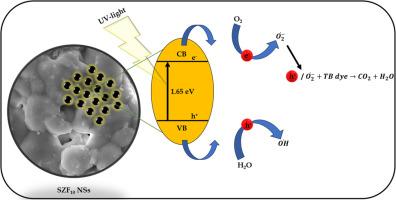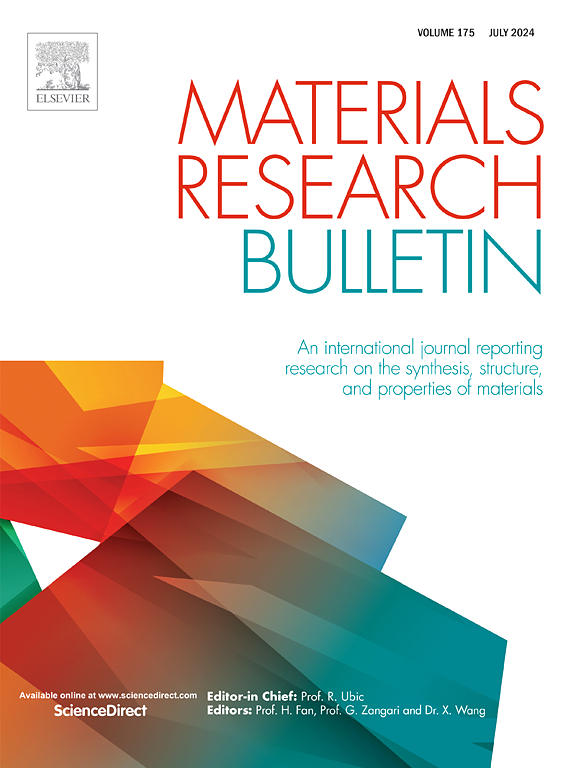Fe-doped SrZrO3 nanostructures as photocatalyst: Solid-state synthesis and UV-light driven eradication of thymol blue dye
IF 5.3
3区 材料科学
Q2 MATERIALS SCIENCE, MULTIDISCIPLINARY
引用次数: 0
Abstract
In this study, pristine and Fe-doped Strontium Zirconate (SZF0 and SZF10) nanophosphors were synthesized using a simple solid-state method. The structural and optical properties of the synthesized materials were extensively characterized using Powder X-ray Diffraction (PXRD), UV–visible spectroscopy, Raman spectroscopy, Field Emission Scanning Electron Microscopy (FESEM), and Transmission Electron Microscopy (TEM). The PXRD analysis confirmed the multiple phase purity and crystallinity with #96–900–0228 (orthorhombic) and #96–153–8368 (cubic) of the samples, having calculated crystallite size of 22.2 nm for SZF0 and 21.4 nm for SZF10. UV-visible spectroscopy revealed the quenching of bandgap energies from 3.24 eV to 1.65 eV for effective UV-light absorption. Raman spectroscopy provided insights into the prominent vibrational modes (Ag, B2 g, and B3 g) and structural integrity of the doped and undoped samples. Morphological analysis through FESEM and EDAX affirmed the agglomerated cluster clubbed morphology and stated elements of the SZF10 sample with particle size distribution averaging at 22.11 nm which was well aligned with PXRD results. Meanwhile, the TEM analysis confirms the same with high crystallinity. The photocatalytic activity of the synthesized SZF10 sample was evaluated by degrading TB dye under various experimental conditions. The results show a prominent degradation rate of 81.04 % at the 90th minute. The same results were utilized in studying the kinetics of the degradation process which align with the 1st-order kinetics with k and R2 values of 0.00737 and 0.98034, respectively. The influence of different parameters such as pH, catalyst dosage, and dye concentration on the degradation efficiency was systematically studied to obtain the optimum values.

作为光催化剂的掺铁 SrZrO3 纳米结构:固态合成和紫外光驱动的百里酚蓝染料去除技术
本研究采用简单的固态方法合成了原始和掺杂铁的锆酸锶(SZF0 和 SZF10)纳米磷酸盐。利用粉末 X 射线衍射(PXRD)、紫外可见光谱、拉曼光谱、场发射扫描电子显微镜(FESEM)和透射电子显微镜(TEM)对合成材料的结构和光学特性进行了广泛表征。PXRD 分析证实了样品的多相纯度和结晶度,分别为 #96-900-0228(正方体)和 #96-153-8368(立方体),SZF0 和 SZF10 的计算结晶尺寸分别为 22.2 nm 和 21.4 nm。紫外可见光谱显示,带隙能量从 3.24 eV 减小到 1.65 eV,从而实现了对紫外光的有效吸收。通过拉曼光谱可以了解掺杂和未掺杂样品的主要振动模式(Ag、B2 g 和 B3 g)和结构完整性。通过 FESEM 和 EDAX 进行的形态学分析证实了 SZF10 样品的团聚聚类形态和所述元素,其粒度分布平均为 22.11 nm,与 PXRD 结果完全一致。同时,TEM 分析也证实了同样的高结晶度。通过在不同实验条件下降解 TB 染料,评估了合成的 SZF10 样品的光催化活性。结果表明,在第 90 分钟时,降解率达到 81.04%。同样的结果也被用于研究降解过程的动力学,结果符合一阶动力学,k 值和 R2 值分别为 0.00737 和 0.98034。系统研究了 pH 值、催化剂用量和染料浓度等不同参数对降解效率的影响,以获得最佳值。
本文章由计算机程序翻译,如有差异,请以英文原文为准。
求助全文
约1分钟内获得全文
求助全文
来源期刊

Materials Research Bulletin
工程技术-材料科学:综合
CiteScore
9.80
自引率
5.60%
发文量
372
审稿时长
42 days
期刊介绍:
Materials Research Bulletin is an international journal reporting high-impact research on processing-structure-property relationships in functional materials and nanomaterials with interesting electronic, magnetic, optical, thermal, mechanical or catalytic properties. Papers purely on thermodynamics or theoretical calculations (e.g., density functional theory) do not fall within the scope of the journal unless they also demonstrate a clear link to physical properties. Topics covered include functional materials (e.g., dielectrics, pyroelectrics, piezoelectrics, ferroelectrics, relaxors, thermoelectrics, etc.); electrochemistry and solid-state ionics (e.g., photovoltaics, batteries, sensors, and fuel cells); nanomaterials, graphene, and nanocomposites; luminescence and photocatalysis; crystal-structure and defect-structure analysis; novel electronics; non-crystalline solids; flexible electronics; protein-material interactions; and polymeric ion-exchange membranes.
 求助内容:
求助内容: 应助结果提醒方式:
应助结果提醒方式:


